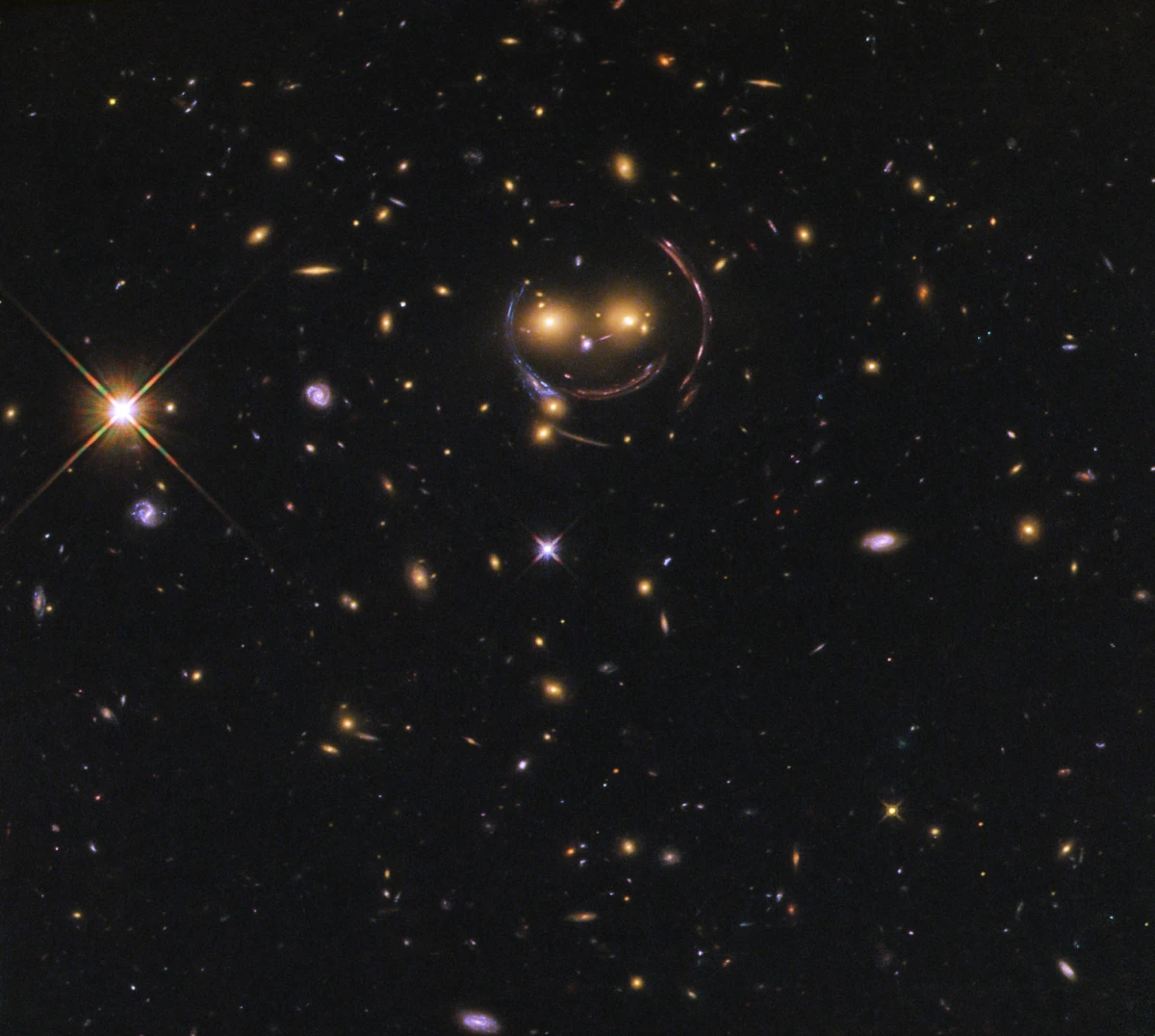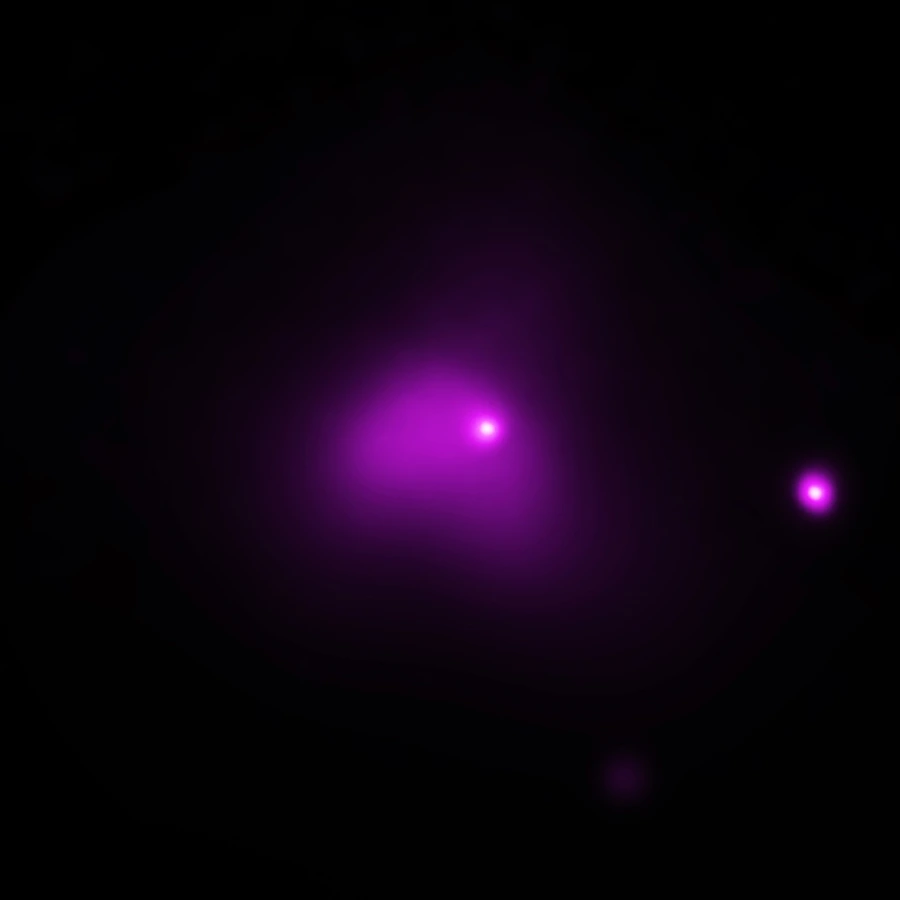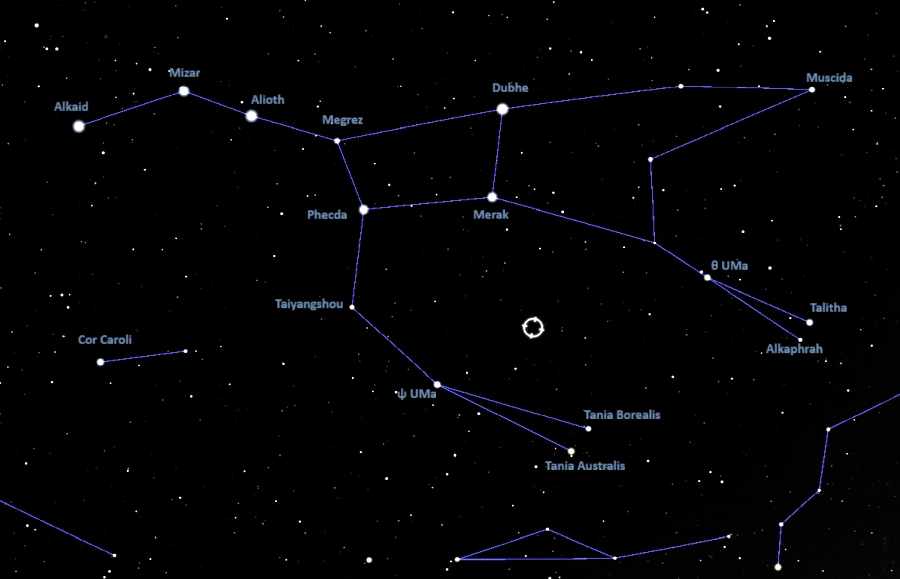The Cheshire Cat galaxy group (CSWA-2, SDSS J103842.59+484917.7) is a grouping of galaxies located approximately 4.6 billion light-years away in the northern constellation of Ursa Major. It consists of two clusters of galaxies that are approaching each other at 1,350 km/s. The galaxies appear as a smiling face reminiscent of the fictional Cheshire Cat from British author Lewis Carroll’s Alice’s Adventures in Wonderland (1865).
The cosmic grinning cat is the product of gravitational lensing, a phenomenon predicted by Albert Einstein’s Theory of General Relativity over a century ago. The Cheshire Cat is one of the many gravitational lens systems discovered in recent decades, but it is one of a very few with such a striking appearance.
Gravitational lensing is more than just a cosmic trick of the eye. It provides scientists with a unique way to study deep sky objects that lie at great distances. Without the lensing and magnifying effect, astronomers would not be able to see these objects, even in the largest of telescopes. The lensed light of distant deep sky objects appears as Einstein rings and crosses around the massive objects that serve as gravitational lenses.

Cheshire Cat galaxies, image credit: Judy Schmidt (CC BY 2.0)
Other well-known examples of gravitational lens systems include the Cosmic Horseshoe in the constellation Leo, the Sunburst Arc galaxy (the home of the Godzilla star) in Apus, the Einstein Cross in Pegasus, HE 0435−1223 in Eridanus, the 8 o’clock Arc in Pisces, and the Cosmic Snake, lensed by the cluster MACSJ1206.2-0847 in Virgo.
The Cheshire Cat system was discovered by a team of astronomers led by V. Belokurov of the Institute of Astronomy, University of Cambridge, UK, during the Cambridge Sloan Survey of Wide Arcs in the Sky (CASSOWARY) in 2008. The CASSOWARY survey aimed to systematically search the sky for wide-separation gravitational lens systems. The discoverers named the system the Cheshire Cat because of its broad smile. The study announcing the discovery was published in the Monthly Notices of the Royal Astronomical Society in January 2009.
The eyes of the Cheshire Cat are marked by the galaxies catalogued as SDSS J103843.58+484917.7 and SDSS J103842.68+484920.2. The eastern eye, SDSS J103843.58+484917.7, is the brightest galaxy in the cluster G1 and the western SDSS J103842.68+484920.2 is the brightest in the G2 group. One group was already a fossil group before the collision, while the other was a near-fossil group.

One hundred years ago this month, Albert Einstein published his theory of general relativity, one of the most important scientific achievements in the last century. A key result of Einstein’s theory is that matter warps space-time, and thus a massive object can cause an observable bending of light from a background object. The first success of the theory was the observation, during a solar eclipse, that light from a distant background star was deflected by the predicted amount as it passed near the Sun. Astronomers have since found many examples of this phenomenon, known as “gravitational lensing.” More than just a cosmic illusion, gravitational lensing provides astronomers with a way of probing extremely distant galaxies and groups of galaxies in ways that would otherwise be impossible even with the most powerful telescopes. The latest results from the “Cheshire Cat” group of galaxies show how manifestations of Einstein’s 100-year-old theory can lead to new discoveries today. Astronomers have given the group this name because of the smiling cat-like appearance. Some of the feline features are actually distant galaxies whose light has been stretched and bent by the large amounts of mass, most of which is in the form of dark matter detectable only through its gravitational effect, found in the system. More specifically, the mass that distorts the faraway galactic light is found surrounding the two giant “eye” galaxies and a “nose” galaxy. The multiple arcs of the circular “face” arise from gravitational lensing of four different background galaxies well behind the “eye” galaxies. The individual galaxies of the system, as well as the gravitationally lensed arcs, are seen in optical light from NASA’s Hubble Space Telescope. Credit: NASA/STScI (PD)
The Cheshire Cat’s smile is formed by one of the distant galaxies whose light is bent and distorted into an arc just below the Cat’s eyes. The multiple arcs that form the Cat’s face are formed by four different background galaxies that lie well beyond the eyes.
The light of the distant galaxies is bent by large amounts of mass in the foreground. Most of this mass is in the form of dark matter, whose presence can only be inferred based on its gravitational effect. Belokurov et al. found a mass of around 33 × 1012 M⊙ within the larger arc of the galaxy group, with a radius of 11 arcseconds.
The light of the background galaxies is stretched by the massive galaxies in the foreground. The galaxies that form the Cat’s eyes and the smaller galaxies associated with them are speeding towards each other, leading the two systems into a giant galactic collision. Data obtained with the Chandra X-ray Observatory has revealed that the hot gas in the galaxy groups has been heated to millions of degrees, which is strong evidence for interaction between the groups. Chandra has also uncovered an active supermassive black hole at the core of the Cheshire Cat’s left eye.

Astronomers think that in the future the “Cheshire Cat” group will become what is known as a fossil group, a gathering of galaxies that contains one giant elliptical galaxy and other much smaller, fainter ones. Today, researchers know each “eye” galaxy is the brightest member of its own group of galaxies and these two groups are racing toward one another at over 300,000 miles per hour. Data from Chandra (purple), which has been combined with optical data from Hubble, show hot gas that has been heated to millions of degrees, which is evidence that the galaxy groups are slamming into one another. Chandra’s X-ray data also reveal that the left “eye” of the Cheshire Cat group contains an actively feeding supermassive black hole at the center of the galaxy. Credit: X-ray: NASA/CXC/UA/J.Irwin et al; Optical: NASA/STScI (PD)
The giant “eye” galaxies and the “nose” galaxy are surrounded by the mass that acts as the gravitational lens. In about a billion years, the two eyes will merge to form a “Cyclops.”
The Cat’s eyes are giant early-type galaxies. The luminous elliptical galaxies are believed to be responsible for most of the lensing. The Cat’s nose is likely a foreground object.
The western eye of the Cheshire Cat has a double nucleus that appears off-centre in the galaxy’s extended stellar halo. The two nuclei are separated by 0.37 arcseconds, corresponding to a physical distance of 2.1 kiloparsecs (6,849 ly). The northeastern core has an active galactic nucleus (AGN).

The image is an X-ray image of a group of galaxies called SDSS J103842.59+484917.7, also known as the Cheshire Cat. The dominant colors in the image are purple and black with pops of pale gold. The structure of the Cheshire Cat resembles a smiling face, which can be seen in the center of the image. The Cheshire Cat’s appearance is due to gravitational lensing, where the mass of the galaxy cluster bends and distorts light passing through it, creating an optical illusion of a smiling face. Specifically, the mass that distorts the faraway galactic light is found surrounding the two giant “eye” galaxies and a “nose” galaxy. Credit: X-ray: NASA/CXC/UA/J.Irwin et al; Optical: NASA/STScI (PD)
Astronomers believe that the Cheshire Cat galaxies will ultimately become a fossil group, an end-result of a galaxy colliding with a normal group of galaxies. Fossil galaxy groups typically consist of a large elliptical galaxy with an extended X-ray halo of gas as a remnant of the progenitor group. At the time of discovery, the Cheshire Cat galaxy group was the first example of a galaxy group in the early stages of becoming a fossil group. It provided astronomers with the first opportunity to study the evolution of a fossil group progenitor.
The Cheshire Cat galaxy group lies in the northern sky, in the constellation Ursa Major. It appears in a relatively inconspicuous part of the Great Bear, in the region between Merak in the Big Dipper and Tania Borealis in the Three Leaps of the Gazelle. The galaxies cannot be observed in amateur telescopes.

Location of the Cheshire Cat, image: Stellarium
Cheshire Cat galaxy group
| Constellation | Ursa Major |
| Object type | Gravitational lens system |
| Right ascension | 10h 38m 43.58s |
| Declination | +48° 49′ 17.7″ |
| Distance | 4.6 × 109 light-years |
| Redshift | z = 2,196 |
| Radial velocity | 246327 km/s |
| Names and designations | Cheshire Cat, CSWA 2, SDSS J1038+4849, [KAA2009] SDSS J1038+4849 |